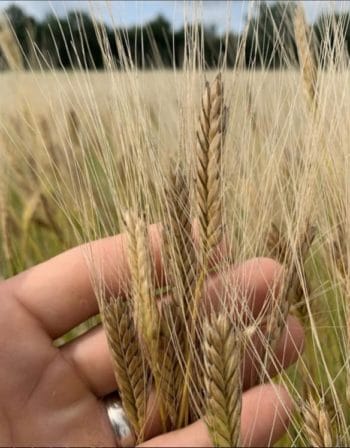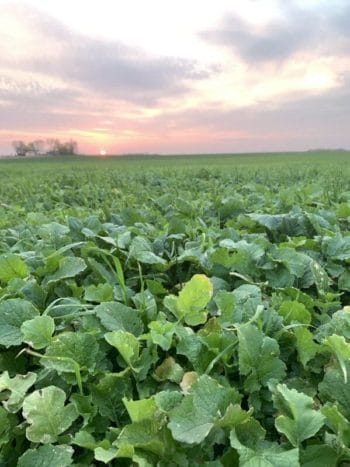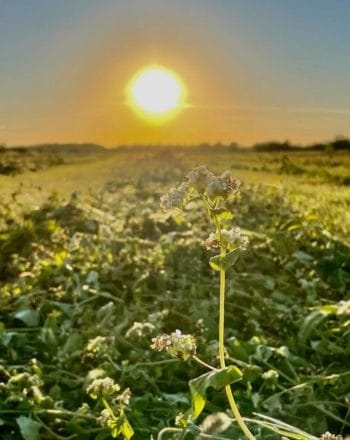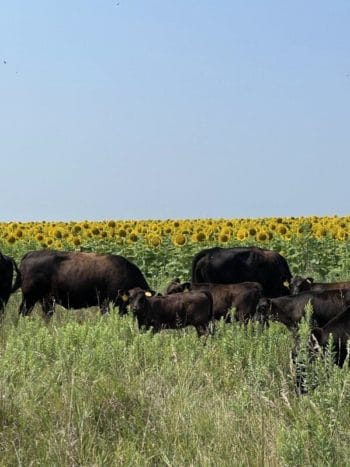Finding Your Small-Grain Market Through Relationship Building
Luke Peterson of Dawson, Minnesota, began farming in 2013. In his first year of conventional farming, he made the decision to transition to organic production. He then started transitioning his farm, Luke Peterson Farms, formally A-Frame Farm, to regenerative farming.
Luke started the transition to regenerative practices by introducing a wheat crop into his corn and soybean rotation. With inspiration from Gabe Brown and other pioneering regenerative farmers, he built his own rotations. Last growing season, he grew eleven different crops in rotation and continues to explore the possibilities by adding new things.
Luke uses the Haney test each year to figure out what nutrients need to be added or what crop needs to go in next. He also has a rotation that he sticks to: grass, legume, grass, legume, and then a big period of rest with alfalfa, Kernza or pasture.
He gets seed from Albert Lea Seed who has been a resource to him while growing his rotation.
Wheat in Organic Rotations and Fall No-Till
The first wheat field he planted was under seeded with red clover. Luke says this is an easy practice for planting cover crops as you drop the red clover seed on top of the ground while planting wheat. When the wheat was harvested, he mowed the clover four times that fall. The volunteer wheat fills any holes, leaving little bare ground.
Luke Peterson Farms went away from under seeding red clover when the farm switched to no-till in the fall of 2018. Luke discovered that leaving the red clover in the ground until spring made it hard to get a field cultivator to reach the ground. That year he had to chisel plow and ended up doing more tillage than he had intended.
Spring wheat is no-till drilled into soybean stubble in the spring. He then goes in with a no-till drill and plants a mix of turnips, tillage radish, sunflowers and 40 pounds of peas. He has dropped the seeding rate on the turnips and radish to 2.5 pounds each, which allows the plants to bush out more, the volunteer wheat to fill in and the peas to flourish.
The cover crop starts to shrink and freeze in December in the fields that are planted this way. In the spring it will have little residue and be ready for planting, which is what Luke wants as an organic farmer. The weed pressure is minimal in this type of rotation. After the summer cover crop winterkills, Luke grows corn.
When Luke worked the soil in the spring, he would have to wait longer for the soil to be suitable for planting. Eliminating fall tillage, along with purchasing a no-till drill, has allowed him to get into the fields up to three weeks earlier than neighboring farmers. He has gone out at night and pushed the spring wheat into the frozen ground to get a head start on weed control. Wheat germinates at a lower temperature than broadleaf weeds, so getting the wheat growing first uses natural competition to get ahead of the weeds.
Niche Grains Markets
Ten years ago, grain markets were harder to find, and Luke sold to local mills, bakeries and restaurants who only purchased a tote or two at a time. Now he sells 300 bushels at a time.
Luke has seen an increase in the demand for gluten-free grains. This creates opportunities for farmers to grow buckwheat, flax and other grains that don’t have gluten. He has also noticed an increase in the demand for food grade oats and peas for protein powders.
Most of the farms’ grains are grown for small local markets, including spring wheat, naked oats, ancient wheat and Kernza. Naked oats are a cereal grain that lose their husk naturally during the harvest and threshing process. The small demand for these oats comes from bakeries or small mills. Luke grows it, cleans it, bags it and sells it either by the pallet or by the 50-pound bag.
Emmer and einkorn are ancient wheat species that also have small markets. Luke sells it by the pound and not the bushel. Buyers for these grains are usually long term and committed. Kernza, a perennial intermediate wheatgrass, is grown for food and forage. Luke works with breweries around the country to sell Kernza for the craft beer market.
Building a Market
In addition to the added value from organic and regenerative farming practices, Luke’s farm has had to get to know the supply chain. When building supply chain relationships, he finds people that find the value in growing unique crops for functional products.
One way Luke builds relationships is by connecting with people across the supply chain. Bringing them to his farm, he’s able to show them the practices he uses and the challenges he faces. He isn’t just selling his crops to these businesses; he is selling the ecosystem services that those crops provide, such as clean water and healthy soil.
Luke says, “If you’re selling them sunflowers, at the end of the day they are buying sunflowers regardless of the work that went into growing them. One way we have started to create value for the buyers, so we can get paid a competitive price and keep access to the land is by bringing the consumers and buyers to the farm.” At one of these field days, Luke made a hard pitch to the attendees. He said,
“We should stop valuing a crop on its volume and start valuing the farm as a system.”
This concept might take a little while to catch on.
Finding an organization, such as the Artisan Grain Collaborative or the Perennial Promise Growers Cooperative can be beneficial when you want to diversify your farm with different small-grain crops. If you are hesitant, stick with a crop where you have multiple markets in case one falls through.




